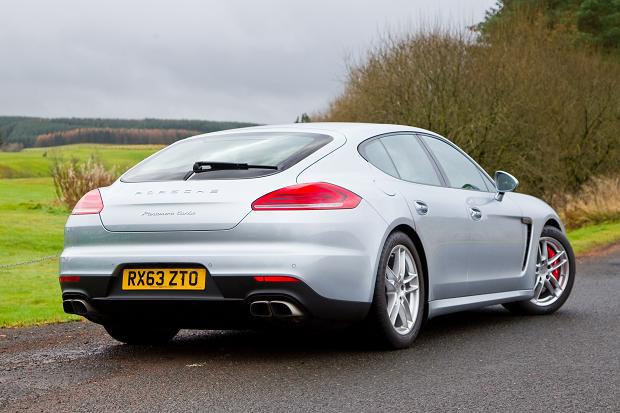We review the Porsche Panamera Turbo (2014) from price to economy and all its features

WHAT’S the easiest job in the world? Joey Essex’s University Challenge opponent, Mike Tyson’s bodyguard or Bruce Willis’ hairdresser?
They’d all be easy, but not as big a walk in the park it is to be a Porsche car designer.
You get the feeling this is how a normal day unfolds in their Stuttgart HQ: Porsche big boss: “Morgen Herr Stylist, we need to design a new model.”
Herr Stylist: “OK which model?”
Porsche big boss: “All of them — 911, Panamera, Cayman and Cayenne.”
Herr Stylist: “No problem I’ll take the rest of the year off. They are fine as they are. Auf wiedersehen.”
This is the new Panamera. Yes, it looks just like the old one, like all new Porsches. That’s because you need to be a boffin of Stephen Hawking proportions to spot the differences.
I have been reassured by Porsche that their four-door saloon has been resculpted at the rear end, receiving new bumpers front and rear as well as some suspension changes designed to smooth out its ride and lessen road noise.
The big news elsewhere in the range is the launch of a plug-in hybrid version, and the arrival of a new Porsche-designed bi-turbo V6. But it’s the tonking Turbo that we’ve had a first drive of in Scotland this week.
Its reign as the quickest of the new Panameras was ended last week. The Macan wasn’t the only new Porsche in LA – the Panamera Turbo S also made its debut.
0-62mph in 3.8 seconds all the way to 192mph
It joins the Turbo and hybrid models in the four-door’s line-up but pumps out 49bhp more than the standard Turbo to 562bhp.
It goes from 0-62mph in 3.8 seconds all the way to 192mph. Buyers can spec the optional sports exhaust system too, which pumps the engine note directly into the interior for a more dramatic sound.
But it costs a whopping £23,146 more than the Turbo model I’ve just had a first drive of in Scotland — which makes this one seem like a bargain at £107,903. Well, sort of. I admit to disliking the look of the first Panamera initially.
But having spent a lot of time in them — especially on a Loch Lomond to Land’s End marathon drive — I don’t think styling matters, I totally fell for the car. That hasn’t changed.
Colour choice is vital to make the Panamera easier on the eye, black paintjob and black alloys sort of hides the never-ending back-end.
I’d say it’s more striking, with lots of road presence and personality, than beautiful.
More Motors
In spite of the car’s length, width and weight, the Panamera can still be jostled through corners with enough agility to make you beam with pleasure.
There’s plenty of grip with Sport and Sport Plus settings that tweak suspension, throttle and steering settings to progressively make the car react quicker and feel sportier.
All this pace is delivered with grace while cocooned in one of the best cockpits a car can offer.
If you thought it difficult to differentiate the first and second generations of Panamera from the outside, you’ll have even more trouble inside — they’re identical. Build quality is superb, but the dash is dominated by a buttonfest of a centre console. But I still love it — more buttons for yer money is my thinking.
It looks just like the old one, like all new Porsches
It’s still not that practical, despite being a four-seater, four-door. The tiny 445litre boot is smaller than a Honda Civic but very shallow to allow the swooping-shaped rear three quarters of the car which makes loading anything squarish a bit challenging.
The Panamera has its faults and will continue to divide opinion. But on its own merits, it’s a fabulous car to drive and live with.
The diesel will remain the biggest seller by some margin, offering a possible 44mpg for £62,922. But for footballers and others for whom money is no object, this Turbo and the new Turbo S are definitely on the radar.
And, remember, Porsches hold their value better than any other car. That’s because the next model never changes in design. Ahh, smart move, Herr Stylist.






